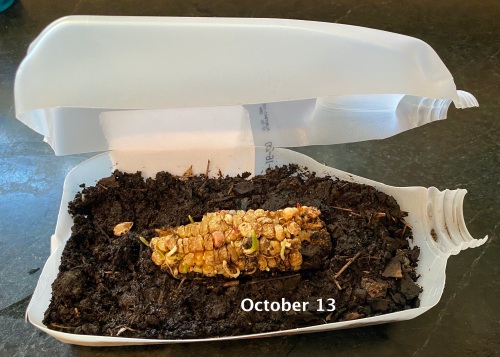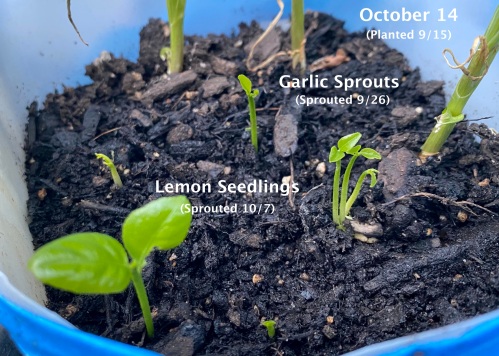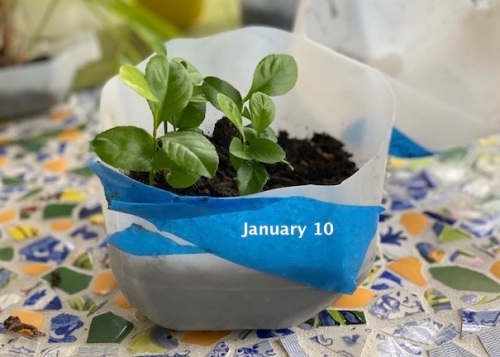Last spring, while visiting my friend Mary’s vegetable garden, I spied this group of milk jugs planted with vegetable seedlings.

Mary said she started using recycled milk jugs to start seeds when she saw another gardener doing so. We, gardeners, enjoy learning from each other!
The beauty of milk jug sprouting is once you plant seeds, moisten the soil, and tape up the sides, you can pretty much ignore the emerging seedlings until they are ready to be transplanted; no need for babysitting. The almost closed system keeps moisture in and uses the warmth of sunlight to nudge seeds from dormancy to germination. It is an efficient, green, portable, fun, easy-peasy way to start seeds.
I left Mary’s garden and headed home; I had an idea. A murder of crows had been invading my little backyard corn patch, digging up most of the seedlings as they sprouted.

By the way, the birds were after the kernel, not the green blades which they left behind. Arghhh. This bummed me out because I was nearing the end of my prized stash of Kentucky Rainbow Heirloom Dent Corn from Susana Lein’s Salamander Springs Farm in Berea, Kentucky.

Planting seeds in jugs seemed like the perfect way to grow a quick and controlled crop to replace what I had lost. I cut two jugs in half, filled them with dirt, seeds, and water, and taped them up.

Eleven days later, I opened the jugs and planted the bushy seedlings.

I covered the bed with shade cloth to keep all marauders out.
It took about one minute for a crow to pull out the first seedling when I uncovered the bed. I set up a perimeter of string and dangling, flashy CD’s.

And an owl.

The plants did well. They grew as high as an elephant’s eye.

Eventually, I harvested and cooked the delicious, earthy-tasting ears.

Why do I love this corn? It is unusually savory instead of sweet. I love to roast the ears with a little olive oil and salt and cut the kernels off the cob. YUM!


The story doesn’t end there. (Does it ever?)
When I was cleaning out my garden tote in mid-October, I found these moldy, sprouting ears of Kentucky dent corn. I couldn’t throw them out.

I took one and stuck it in a recycled half-gallon jug.

I expected it to rot. Instead, it took off! I was thrilled by the unexpected growth from the individual kernels of corn on the cob. Many months later, the little jug garden is still thriving.

The scientist in me had to see if the sprouted cob was a fluke or if the results could be reproducible. I planted a two-year-old cob I had saved to show students an example of incomplete pollination. It, too, took off.

Plant a Seed with a Child and Share the Thrill of Growing Food Together
Milk jug gardening can be a fun, inexpensive, educational activity to do with children. Imagine how impactful it could be for a child to bring homegrown food to the dinner table, even if it’s only a few leaves of parsley or radish sprouts.


Free seeds for growing food can be obtained from seed exchanges at public libraries across the country.

During COVID, the Nashville Public Library Seed Exchange has let residents check out seeds online and pick them up curbside at one of their branches. This is what the seed bank looks like at one of the branches.

The seeds are donated by local gardeners. Members of one local non-profit, The Herb Society of Nashville, save seeds from their home gardens and get together seasonally to package them.

How to Make a Milk Jug Greenhouse:
Supplies:

clean, plastic milk jugs (gallon and half-gallon sizes)
scissors
store-bought seed-starter dirt or the richest dirt you can find outside
a shovel or cup to spoon dirt into jugs
blue or masking tape
a marker
seeds
water
Instructions:
1. Using scissors, cut around the base of a clean jug about 4 inches from the bottom, leaving the plastic under the handle uncut to serve as a hinge for the greenhouse’s upper half.

2. Fill the jug with 3-4 inches of dirt. I have had good results using dirt from my garden. You could also buy bags of clean seed-starting potting soil.
3. Plant the seeds of your choice. It is fun to try seeds you may have in the house. I cut open a lemon, pulled out five seeds, and planted them, as well as a few cloves of garlic.

They all sprouted and continue to grow. I transplanted the garlic outdoors.

Months later, the lemon seedlings are still going strong!

4. Dribble water into each container until the soil is damp but not sopping wet. I do not put drainage holes in the bottom so I can bring the containers indoors.
5. Close the hinged top and tape around the cut edges of the plastic. Leave the jug spout uncovered for a little air circulation.
6. Label the container.
7. Place greenhouses outside if warm or inside in a sunny window if cold. After I planted the corn seeds, I went out of town for a week and left them untended. The seedlings flourished in my absence.
Radishes are good to grow if you want to see quick results but know that they do not transplant well. Keep the seedlings growing in the jug and encourage children to snip the greens to put in a salad or use in a sandwich.


Sowing seeds, tending plants, and harvesting food and flowers produce feelings of great satisfaction, joy, and wonderment while nourishing the body, mind, and spirit. Milk jug gardening is a fun and portable way to get started.
Happy Gardening!
Related Stories
How to Build a 4 x 4 Raised Garden Bed
Spring Planting Guide for Your Kitchen Garden
Growing and Cooking Sweet Potatoes!
Lemon Tree Very Pretty
Family Dirt
Asteraceae: My Favorite Family of Pollinator Plants
How To Curbside Recycle
Follow Judy’s Chickens on Instagram and Pinterest @JudysChickens.
If you enjoyed this post, consider becoming a follower. Be sure to press “confirm” on the follow-up letter sent to your email address.
© 2014-2021 Judy Wright. All rights reserved. Photos, videos, and text may not be reproduced without the written consent of Judy Wright.


Great story!
Thanks, JC! A grandmother project! xo
Great post — I want to give it a try. Thanks.
Thanks! Write back and let us know how it goes!
Judy,
Love this blog post! Can I share it on FB? I couldn’t find it when I looked.
So many overwhelmed mothers out there looking for projects. This is just fabulous.
Kim
Kim Barrick Studio http://www.kimbarrickstudio.com
Sent from my iPhone
>
Please do! There is an icon at the bottom of the post for sharing on Facebook. THANK YOU for your generous words! x
I am definitely going to do this, Judy. Especially with our tomatoes and morning glories. We did not get to enjoy them much before the weather turned.
How do you water the seeds in the jugs once they are starting to get established?
Those corn seedlings in the photo- they got whatever rain fell in the spout over the 11 days before I planted them. The water condensation in the jug kept the dirt moist.
Their own little micro-climate. I love this idea.
Yes!!! Thanks!
What a great idea…I’m going to do this with zinnias this years as my seeds were a total flop last year!
>
I saved some of my favorite zinnia seeds which I am happy to share with you, Susan.
Great timing on this post. It’s been a bit cold and dark, but today the sun and Judy are promising spring! Very cool Judy.
Thank you!! Always a positive outlook coming from you, Kim. xo
This is a fantastic post! I may even try it 😉 I am not much of a gardener but you are inspirational, Judy!
Thanks, Melinda. I think it would be great for starting or adding to an herb garden. I’ll help you plan!
Loved reading this Judy. You managed to capture the curiosity, fun, and even suspense felt by an avid gardener. Thanks for sharing.
Thanks, for the generous compliment, Lydia!
Where did you get your garden bed hoops? Online sources I have found do not have good reviews. Love the milk jugs.
Thanks! I bought the hoops at Gardens of Babylon about 8 years ago
What a great idea, Judy! And when you’re done with the jugs you can still recycle them. Thank you for sharing, and please thank your friend as well. Kathy Hilmer
>
Thank you. While I direct seed most of my veggie plants, getting some plants started can be tricky and this method guarantees good results. I’ve found I can no longer throw a jug in the recycle bin! Happy gardening and thanks for writing!
WONDERFUL!
>
Thank you, Ginger!!
I enjoyed reading about this project! Looking forward to recycling milk jugs and starting
a small vegetable patch for spring!
Thank you! A neighbor read this and dumped a haul of recycled jugs in my backyard! I hope to start some seed projects with children in the neighborhood when the temperature warms up. Happy jug-planting!
This is wonderful! Thank you. (Note to self: SAVE THE JUGS!)
I doubt I’ll ever be able to throw another jug away! Thanks for writing!
Love this post and all the great pictures!
Morning!
Signing up for gardening tips and new posts!
Thank you!! Hope you enjoy!
Does the lid have to be put on?
No.